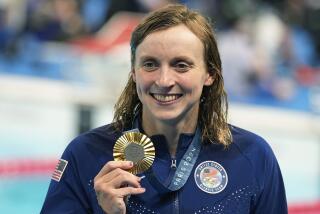Merging Into the Fast Lane : CLASS Aquatics’ Larsen Making Dramatic Gains in Her Brief Career
- Share via
Alexis Larsen grew an inch since the beginning of summer, but her stature in women’s swimming grew even more.
Both growth spurts came suddenly for the 5-foot-4, 14-year-old from Pacific Palisades who swims for Calabasas-based CLASS Aquatics.
Last month in the U.S. Olympic Festival, Larsen won the 800-meter freestyle in 8 minutes 46.54 seconds and qualified for next year’s Olympic Trials. In the past nine months, she has improved her time more than a minute.
Then, last week in the National Junior Olympics West meet in Mission Viejo, she won the 1,500-meter freestyle in 16:51.63, the 12th-fastest women’s time in the world this year and a 16-second drop for her time from April.
Bud McAllister, her coach since September, is amazed by her progress.
“I’ve never had anyone make that kind of improvement” in such a short time, said McAllister, whose former swimmers include Olympic gold-medalist Janet Evans.
“I knew Alexis could go fast, but I didn’t think she’d see these times for at least another year,” McAllister said. “It’s hard to tell how far she’s going to go.”
She is competing this week in the U.S. Senior National championships in Fort Lauderdale, Fla. She was second Monday night in the 800-meter freestyle with a time of 8:49.66.
In a sport populated with 7-year-olds who are veterans of age-group championship meets, Larsen is a relative infant. She moved from Connecticut to California in 1987 and has swum competitively for only three years. After a short time with the YMCA of Pacific Palisades, she joined Team Santa Monica, coached by John Apgar, when she was 12.
“He worked with me, and I just kept getting better and better,” Larsen said. “And I just started from there and kept going.”
After two years, however, she grew impatient with her progress and decided that she needed a change--especially after seeing others improve after they joined McAllister’s swim club.
The move required Larsen’s mother to drive her during the school year to morning workouts at Pierce College and afternoon sessions in Calabasas. It also required an adjustment to McAllister’s more demanding regimen.
“I was just wiped out that first week,” she said.
After a few months, though, Larsen began to thrive on the heavier workload.
“After he raises the yardage, sometimes going from 8,400 yards a night gradually increased to 9,000, you’re feeling kind of tired.” she said. “It takes only a few days and then you’re back on track again.”
Darlene Bible, coach of the swimming team at Westlake School in Holmby Hills, where Larsen has been a student since the seventh grade, has observed her development for three years.
“She got excited about knowing she was pretty good, and then she really started getting serious,” Bible said. “Now she loves working out and working out hard.”
And that hard work paid off quickly.
In March, Larsen won the National Junior Olympic West short-course 500 in Milwaukee. The following month in the U.S. Spring Nationals in Federal Way, Wash., she finished 13th in the 1,500-meter freestyle in 17:07.64 and 16th in the 800 in 8:59.96.
Then in May, in the Southern Section 2-A Division meet as a Westlake School freshman, she won the 200-yard freestyle in 1:53.11 and the 500 in 4:54.36. She became her school’s first individual champion in that meet since Dara Torres in 1983. Torres went on to become a U.S. Olympian in 1984 and 1988.
McAllister said that next year will give a clearer indication of how far Larsen will ultimately advance. Her strength in distance swimming is an advantage, he said, because that is an area where--with the exception of Janet Evans--the current U.S. program is weak.
“The 400 (Larsen placed second in the Olympic Festival in 4:16.89 and also qualified for the Olympic Trials in that event) and 800 freestyle are wide open as far as no one being close to Janet,” McAllister said. “But Alexis would have to make another substantial drop to move into that position to challenge for second or third at the Olympic Trials. It could happen, but it’s not probable within another sixth months.
“I just told her, ‘You want to go to the trials to get the experience so that in 1996, if you’re still swimming fast, you’ll be a veteran and you’ll know what to do and what to expect.’ ”
What about the inevitable setbacks and disappointments?
“Sometimes it’s hard,” Larsen said. “But usually I figure there’s no one to blame but myself. And I just have to go back to my workouts and work harder and just try and do better next time.”
More to Read
Go beyond the scoreboard
Get the latest on L.A.'s teams in the daily Sports Report newsletter.
You may occasionally receive promotional content from the Los Angeles Times.






